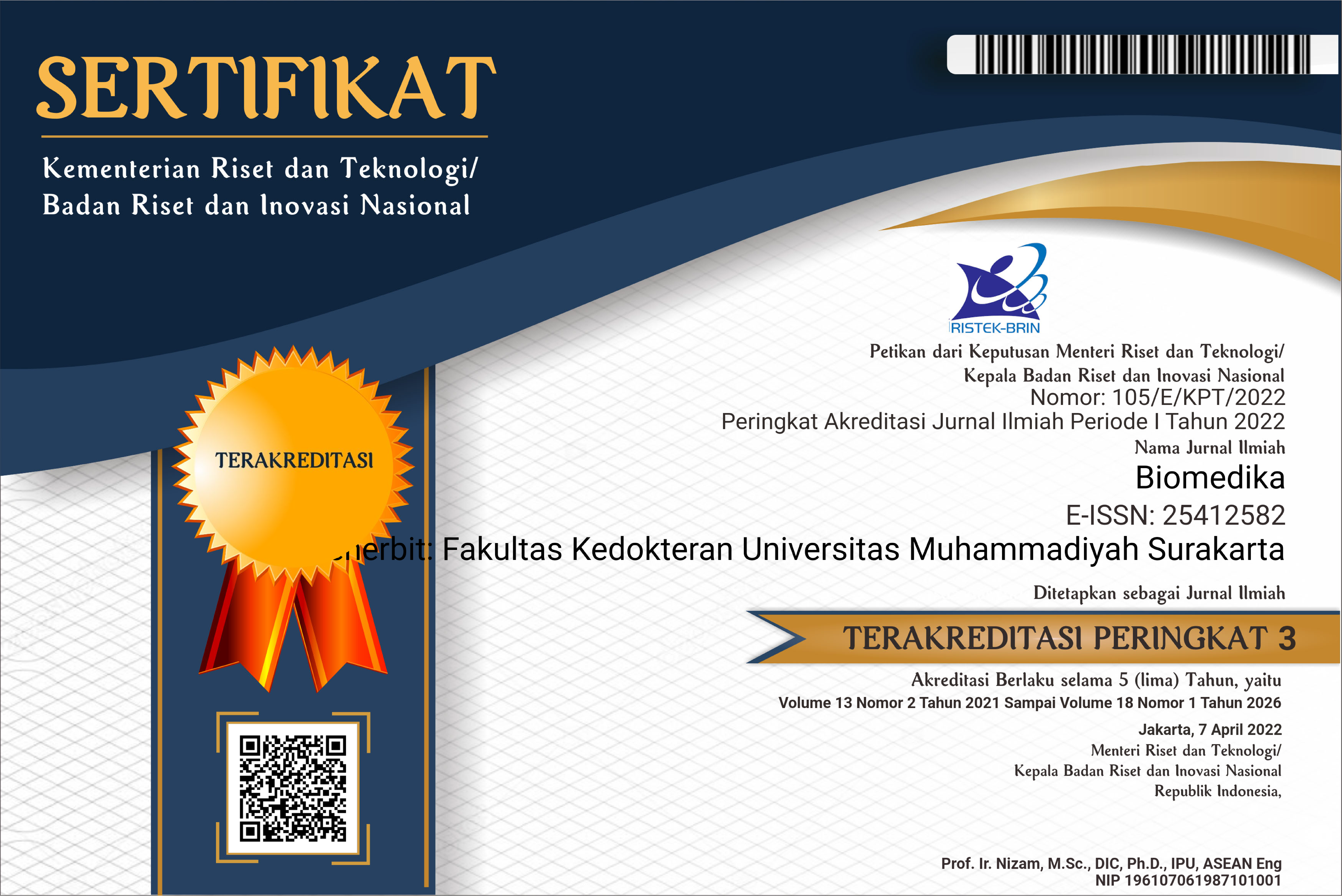INFEKSI NOROVIRUS DENGAN DERAJAT KEPARAHAN DIARE AKUT PADA BALITA DI SURABAYA
Relationship of Norovirus Infection with Severity of Acute Diarrhea in Toddlers in Surabaya
DOI:
https://doi.org/10.23917/biomedika.v15i1.1752Keywords:
Diarrhea, Norovirus, Toddler, PHBS, Diare, BalitaAbstract
ABSTRACT
Diarrhea is one of the most common diseases in Indonesian society. In 2010 there were 411 events per 1000 population per year. Toddlers aged 1-4 years have the highest prevalence, which is around 16.7%. Based on data from the Surabaya City Health Office, diarrheal diseases in the city of Surabaya in 2015 were 65,447 cases. Norovirus, an unenveloped single RNA virus from the family Calciviridae, is the second most common cause of acute diarrhea after rotavirus. The purpose of this study was to analyze the relationship between the severity of acute diarrhea and Norovirus infection in children under five in Surabaya. The study was conducted using an observational analytic method, the research sample was taken by incidental sampling as many as 50 research samples with the criteria of patients suffering from acute diarrhea aged 5 years who came and were treated at the Surabaya Public Health Center. Examination of the RT-PCR method on samples was carried out to determine the occurrence of Norovirus infection. The data collected in the bivariate analysis was tested on two related variables or using the Chi Square statistical test. The results showed that the proportion of pediatric patients aged 5 years with acute diarrhea who were positive for Norovirus infection using the RT-PCR examination method was 38 children. Based on the results of the analysis through calculations using the Vesikari score, there is a significant relationship between the severity of diarrhea and Norovirus infection.
ABSTRAK
Diare menjadi salah satu penyakit yang banyak mengenai masyarakat Indonesia. Pada tahun 2010 terdapat 411 kejadian per 1000 penduduk per tahun. Balita usia 1-4 tahun merupakan prevalensi tertinggi yaitu sekitar 16,7%. Berdasarkan data Dinas Kesehatan Kota Surabaya, penyakit diare di Kota Surabaya pada tahun 2015 sebanyak 65.447 kasus. Norovirus, virus RNA tunggal tak berselubung dari family Calciviridae merupakan penyebab terbanyak kedua diare akut setelah Rotavirus. Tujuan penelitian ini adalah menganalisis adanya hubungan derajat keparahan diare akut dengan infeksi Norovirus pada balita di Surabaya. Penelitian dilakukan dengan metode analitik observasional, sampel penelitian diambil secara incidental sampling sebanyak 50 sampel penelitian dengan kriteria pasien yang menderita diare akut usia ≤ 5 tahun yang datang dan dirawat di puskesmas Surabaya. Pemeriksaan metode RT-PCR pada sampel dilakukan untuk menentukan terjadinya infeksi Norovirus. Data yang terkumpul di analisis bivariat, dilakukan uji terhadap dua variabel yang berhubungan atau menggunakan uji statistik Chi Square. Hasil penelitian menunjukkan proporsi pasien anak usia ≤ 5 tahun dengan diare akut yang positif terinfeksi Norovirus dengan metode pemeriksaan RT-PCR adalah sebanyak 38 anak. Berdasarkan hasil analisis melalui perhitungan menggunakan skor Vesikari, terdapat hubungan yang signifikan antara tingkat keparahan diare dengan infeksi Norovirus.













